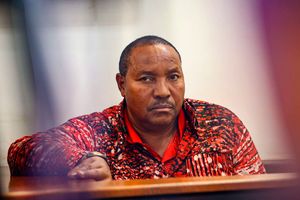Premium
Why is this picture in the ‘Nation’? What’s going on, when and where?

Letter to Santa: A girl writes her Christmas wish list. Captioning photos is a critical function in journalism. The caption, sometimes called cutlines, is the explanatory text printed below a picture.
What you need to know:
- Captioning photos is indeed a critical function in journalism.
- A picture caption should be as accurate and as specific as possible.
- Captions are essential for understanding most pictures
Although an editor can sometimes publish a picture on a whim, there are perfectly good reasons why a particular picture, and the caption, are used. To understand why an editor uses a particular picture, one needs to look at the caption. Incidentally, many readers confuse “caption” with “headline” (title of a story).
The caption, sometimes called cutlines, is the explanatory text printed below a picture. It is one of the most read elements in a story. The reader’s eye often moves from the headline to the picture and the caption before the reader decides whether t to read the rest of the story.
Captioning photos is indeed a critical function in journalism. A picture caption should be as accurate and as specific as possible. Many of the complaints I get are based on erroneous or inappropriate wording of captions.
Captions are essential for understanding most pictures. Although a picture is said to be “worth a thousand words”, there are many things pictures cannot tell, such as the names of the people pictured, when and where the picture was taken and under what circumstances, the mood or emotions of the occasion, and so on.
Inaccurate captions
Editors use captions to enrich and enliven a story. But while an editor decides which particular picture and its accompanying caption is going to run, it is the responsibility of the photographer to write the initial caption and make sure the information is accurate. That is why press photographers are called photojournalists.
If he makes a mistake, the consequences can be dire. Readers can be misled, subjects in the picture embarrassed or scandalised, and the newspaper exposed to defamation suits. There are many instances where inaccurate captions have spelt disaster for newspapers and their readers.
My favourite case – but by no means the most disastrous – is an old one. But its lesson remain true today. It would not have occurred if the photojournalist had asked a simple question: “Madam, may I have your name?”
On September 25, 1977, the Sunday Nation published a story about a golf tournament held at Kericho. A photograph showing a woman presenting the trophy to the winner named her in the caption as Mrs Chesire, the wife of the then-Kenya Tourist Development Corporation Chairman Reuben Chesire. Unfortunately, the woman was not Mrs Lydia Chesire. Morris Masengo, who took the photograph, did not know Lydia Chesire.
The real Mrs Chesire sued for defamation, claiming she had been brought into hatred, ridicule and contempt by the picture and the caption. She said she was also humiliated and distressed because she was a schoolmistress at Elgon Estate Primary School in Nakuru.
Illegitimate children
The words in the caption meant the woman in the picture was Mr Chesire’s lawful wife. Therefore, she was perceived by those who know her to be “a woman of loose, vulgar, unchaste, mean morals, Mr Chesire’s concubine, the mother of his illegitimate children, someone who poses as his lawful wife and, in all, a person who was unfit to be a schoolmistress”.
Justice Zacchaeus Chesoni agreed with her that the picture and caption were defamatory but the defamation was slight “because she sometimes called herself Lydia Cherono Gideon and she had been separated from Mr Chesire for about 10 years”.
He awarded her Sh15,000 damages but the Court of Appeal ruled the award was excessive and reduced it to Sh1,000.
The moral of the story is that simple questions can forestall disaster. If the photojournalist had asked the woman the simple question, “Madam, may I have your name?,” that would have saved Lydia Chesire and the Sunday Nation the embarrassment.
The Public Editor is an independent news ombudsman who handles readers’ complaints on editorial matters including accuracy and journalistic standards. Email: [email protected]. Call or text 0721989264.





